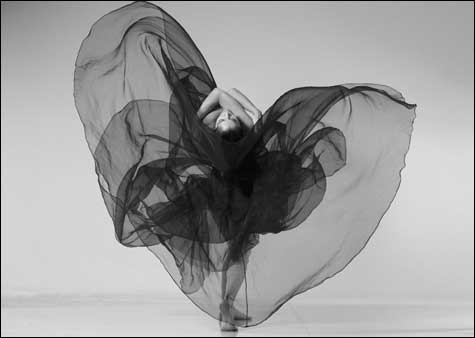
“THE IMMORTAL ROSE”: Machine age meets new age. |
I don’t imagine that when Japanese-born American surrealist dancer Maureen Fleming decided to create a suite of six dances — “Waters of Immortality,” “Dialogue of Self and Soul,” “The Stairs,” “Driftwood,” “Mother and Child,” and “The Immortal Rose” — inspired by the writing of William Butler Yeats, she was planning to evoke the period of the 1920s in which he wrote much of his mature poetry. She was, rather, intrigued by his comment, from 1900, how “the purpose of rhythm . . . is to prolong the moment of contemplation . . . in which the mind liberated from the will is unfolded in symbols.” Nonetheless, with Waters of Immortality, the new and newly repurposed multimedia piece on display at the ICA last weekend, Fleming created a one-woman Art Deco extravaganza — with herself looking like nothing so much as a Rolls Royce hood ornament.
As a performer, Fleming is a wonder of pliancy. In “Dialogue of Self and Soul,” she kneels, bends one knee behind her and reaches over her head to grasp her pointed toe: her body becomes a yogic triangle, bordered by a mysterious biting snake, with a Masonic eye glinting in the empty darkness. In “The Stairs,” she lies upside down with her legs scissoring and floating. Her back bends to become a waning crescent moon braced against a stepped black sky. In “The Driftwood,” the duplicative oval of water at the edge of the stage ripples very slightly as she lies curled at its edge like a piece of beach jetsam, crossing her wrists in a way that transforms her body into a figure eight, a symbol of infinity.

Fleming’s imagery is powerfully loaded and often restful. The problem is that it fails to accumulate into a point of view. Her streamlined, elegant nudity could read as pure, vulnerable materiality. Instead, the choreographer busily polishes each image to a high, and high-minded, gloss where machine age meets new age. Trained by some of the most distinguished butoh masters in Japan, including Kazuo Ohno, and having toured with Ohno’s son and artistic heir Yoshito, Fleming scours that tradition of its rage, sorrow, and existential politics, leaving only erotic reverie.
Commissioned by Boston presenter World Music/CRASHarts and a consortium that includes the Japan Foundation Performing Arts Japan, Waters of Immortality can count among its contributions an astute and subtly colored lighting design by Christopher Odo and a shakuhachi player, Akikazu Nakamura, who may have had to go head to head with recorded accompaniment but whose breath offered a welcome raw wind. The A-list participation of photographer Lois Greenfield was harder to discern; most of Waters of Immortality is augmented by close-up video of Fleming’s performance, not still images, and the video was attributed to Odo, Jeff Bush, and Yang Byum Suh. Fleming’s musical choices are dicier: Bruce Brubaker playing Philip Glass scores offered a steadying framework for the slow-moving shapes, but Glass’s Channels and Winds in a recorded version was a bombastic accompaniment to Fleming’s writhing and reaching across the tension of a long white sling.
For Fleming, it seems, flesh offers a spiritual language. But sometimes that language comes up with clichés. I could have done without her Isadora-in-ecstasy twirling with fabric (transparent white clouds of tulle on the video, red and gray on the stage) to the exalted second movement of Henryk-Mikolaj Górecki’s Symphony No. 3. And when her flesh was blown up to a larger-than-life sepia-toned image projected on the back wall and doubled in that oval pool of immortality on the stage floor, I couldn’t help wondering whether this wasn’t the water that drowned Narcissus.